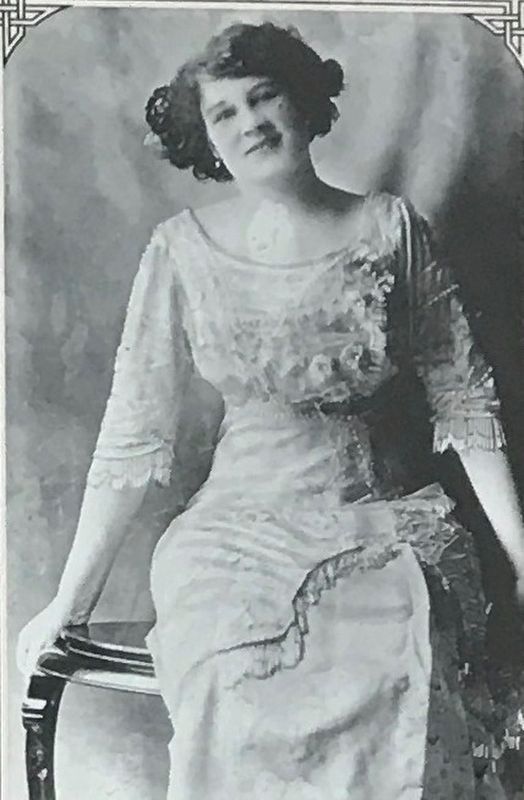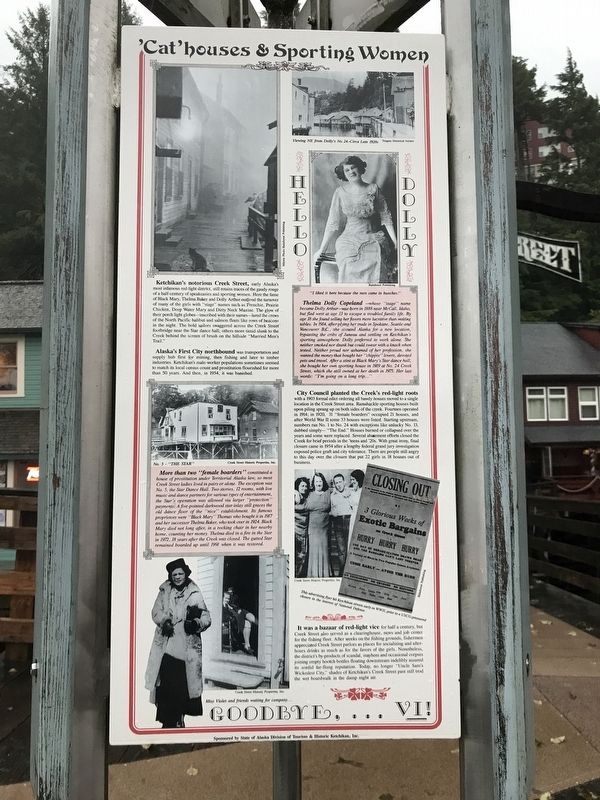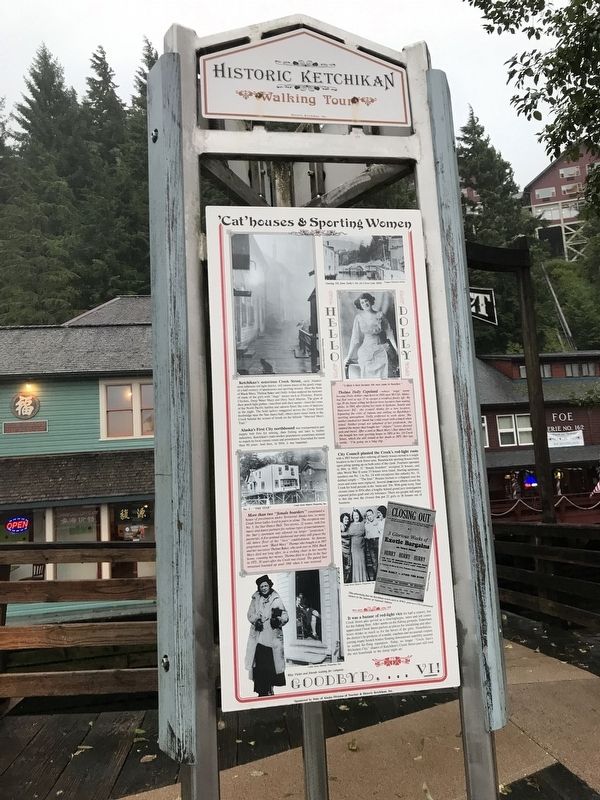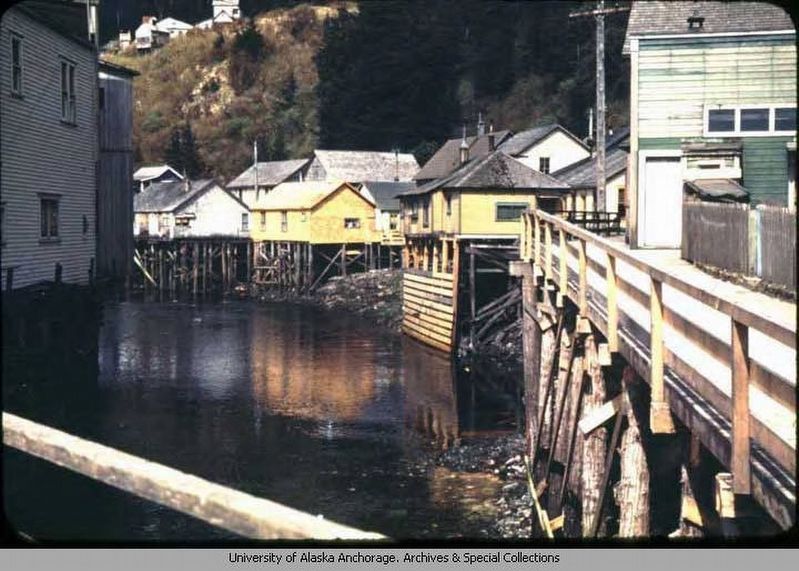Ketchikan in Ketchikan Gateway Borough, Alaska — Northwest (North America)
'Cat' Houses & Sporting Women
Inscription.
Ketchikan's notorious Creek Street, early Alaska's most infamous red-light district, still retains traces of the gaudy rouge of a half-century of speakeasies and sporting women. Here the fame of Black Mary, Thelma Baker and Dolly Arthur outlived the turnover of many of the girls with “stage” names such as Frenchie, Prairie Chicken, Deep Water Mary and Dirty Neck Maxine. The glow of their porch light globes — inscribed with their names — lured the crews of the North Pacific halibut and salmon fleets like rows of beacons in the night. The bold sailors swaggered across the Creek Street footbridge near the Star dance hall; others more timid slunk to the Creek behind the screen of brush on the hillside “Married Men's Trail.”
Alaska's First City northbound was transportation and supply hub first for mining, then fishing and later to timber industries. Ketchikan's male-worker populations sometimes seemed to match its local census count and prostitution flourished for more than 50 years. And then, in 1954, it was banished.
City Council planted the Creek's red-light roots with a 1903 formal edict ordering all bawdy houses moved to a single location in the Creek Street area. Ramshackle sporting houses built upon piling sprang up on both sides of the creek. Fourteen operated in 1914; in 1920, 31 “female boarders” occupied 21 houses, and after World War II some 33 houses were listed. Starting upstream, numbers ran No. 1 to No. 24 with exceptions like unlucky No. 13, dubbed simply “The End.” Houses burned or collapsed over the years and some were replaced. Several abatement efforts closed the Creek for brief periods in the 'teens and '20s. With great irony, final closure came in 1954 after a lengthy federal grand jury investigation exposed police graft and city tolerance. There are people still angry to this day over the closure that put 22 girls in 18 houses out of business.
It was a bazaar of red-light vice for half a century, but Creek Street also served as a clearinghouse, news and job center for the fishing fleet. After weeks on the fishing grounds, fishermen appreciated Creek Street parlors as places for socializing and after-hours drinks as much as for the favors of the girls. Nonetheless, the district's byproducts of scandal, mayhem and occasional corpses joining empty hootch bottles floating downstream indelibly assured its sordid far-flung reputation. Today, no longer “Uncle Sam's Wickedest City,” shades of Ketchikan's Creek Street past still trod the wet boardwalk in the damp night air.
[Sidebars]
Thelma Dolly Copeland — whose “stage” name became Dolly Arthur — was born in 1888 near McCall, Idaho, but fled west at age 13 to
escape a troubled family life. By age 18 she found selling her favors more lucrative than waiting tables. In 1914, after plying her trade in Spokane, Seattle and Vancouver B.C., she scouted Alaska for a new location, bypassing the cribs of Juneau and settling on Ketchikan's sporting atmosphere. Dolly preferred to work alone. She neither smoked nor drank but could swear with a knack when tested. Neither proud nor ashamed of her profession, she wanted the money that bought her “chippie” lovers, devoted pets and travel. After a stint at Black Mary's Star dance hall, she bought her own sporting house in 1919 at No. 24 Creek Street, which she still owned at her death in 1975. Her last words: "I'm going on a long trip …"
More than two “female boarders” constituted a house of prostitution under Territorial Alaska law, so most Creek Street ladies lived in pairs or alone. The exception was No. 5, the Star Dance Hall. Two stories, 12 rooms, with live music and dance partners for various types of entertainment, the Star's operation was allowed via larger “protection” payments. A five-pointed darkwood star inlay still graces the old dance floor of the “nice” establishment. Its famous proprietors were “Black Mary” Thomas, who bought it in 1917 and her successor Thelma Baker, who took over in 1924. Black Mary died not long after, in a rocking chair in her nearby home, counting
her money. Thelma died in a fire in the Star in 1972, 18 years after the Creek was closed. The gutted Star remained boarded up until 1991 when it was restored.
Captions
(Left side, top to bottom)
• [No caption] Milotte Photo/Rainforest Publishing
• No. 5 — “The Star”. Creek Street Historic Properties, Inc.
• Miss Violet and friends waiting for company … Creek Street Historic Properties, Inc.
(Right side, top to bottom)
• Viewing NE from Dolly's No. 24 — circa late 1920s. Tongass Historical Society
• “I liked it here because the men came in bunches.” Rainforest Publishing
• (photo) Creek Street Historic Properties, Inc.; This advertising flyer hit Ketchikan streets early in WWII, prior to a USCG-pressured closure in the interest of National Defense. Rainforest Publishing
Erected by State of Alaska Division of Tourism • Historic Ketchikan, Inc.
Topics. This historical marker is listed in these topic lists: Industry & Commerce • Law Enforcement • Women.
Location. 55° 20.537′ N, 131° 38.569′ W. Marker is in Ketchikan

Photographed By Duane and Tracy Marsteller, September 4, 2021
4. 'Cat' Houses & Sporting Women Marker detail
Dolly Arthur was the most-famous "sporting woman" — her description of herself — on Creek Street, where she lived from 1919 to 1975. Her house is now a museum showcasing Creek Street's red-light era and more.
Other nearby markers. At least 8 other markers are within walking distance of this marker. In Defiance of the Dry Squad (here, next to this marker); Star House (within shouting distance of this marker); Chief Johnson Totem Pole (within shouting distance of this marker); Ketchikan Shingle Mill (within shouting distance of this marker); Sea and Skyline (within shouting distance of this marker); Carving a Place in History (within shouting distance of this marker); Crossing a Frontier (within shouting distance of this marker); Chief Kyan Totem Pole (within shouting distance of this marker). Touch for a list and map of all markers in Ketchikan.
Also see . . .
1. Dolly Arthur: Now Ketchikan's poster girl. By June Allen in Stories in the News (an online news site), posted May 7, 2002. (Submitted on September 18, 2021, by Duane and Tracy Marsteller of Murfreesboro, Tennessee.)
2. History of Creek Street Has Always Been Commerce. By Dave Kiffer in online news site Stories in the News, posted June 10, 2009. (Submitted on September 18, 2021, by Duane and Tracy Marsteller of Murfreesboro, Tennessee.)
Credits. This page was last revised on November 29, 2021. It was originally submitted on September 18, 2021, by Duane and Tracy Marsteller of Murfreesboro, Tennessee. This page has been viewed 402 times since then and 59 times this year. Photos: 1, 2, 3, 4. submitted on September 18, 2021, by Duane and Tracy Marsteller of Murfreesboro, Tennessee.


